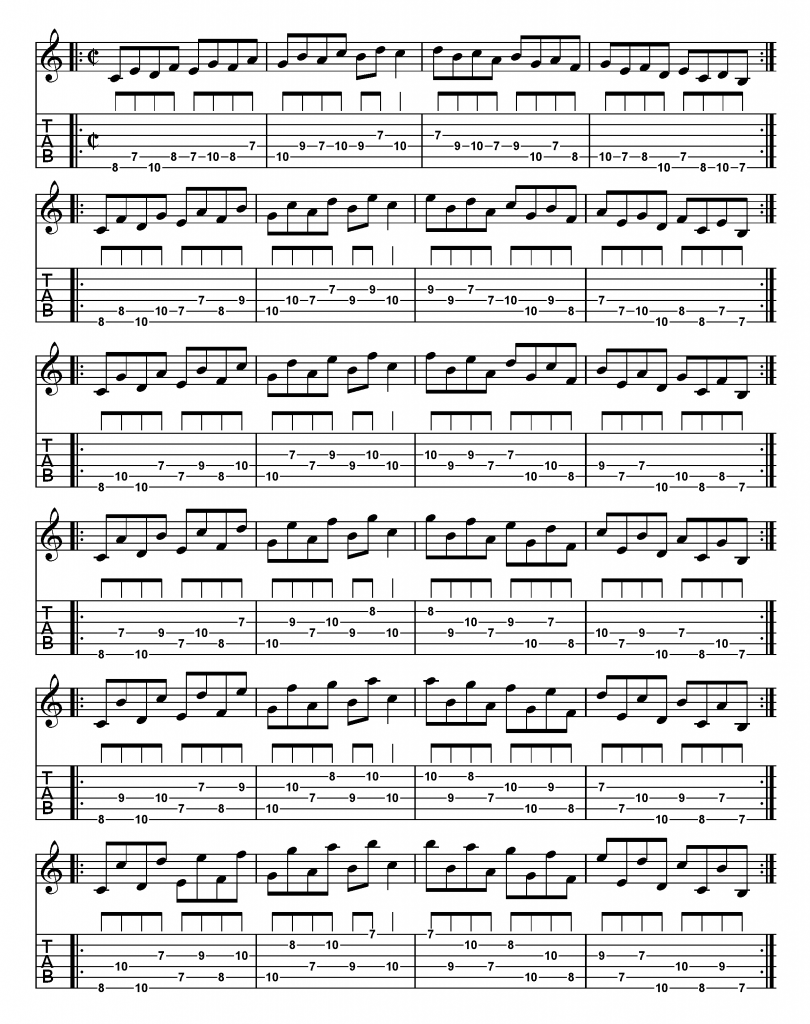Learning Your Scales in Diatonic Intervals
By Pete Sklaroff
Regardless of the style of music you play on guitar, learning scales in diatonic intervals is an important part of your musical development; much like understanding and applying an alphabet is with written or spoken language.
If you are an improviser, you may already be pretty familiar with a number of scales and fingerings, but of course merely playing up and down a scale whilst soloing is not enough to create much interest and melodic contrast in your solos and this is where a good knowledge of intervals is essential.
The exercises below are entirely based on the pitches contained within the C major scale. It progresses through all the available diatonic intervals from thirds right up to octaves.
You will be playing the interval exercises in the following order:
3rds, 4ths, 5ths, 6ths, 7ths and Octaves
These are all played ‘in position’ too (within a span of approximately 4/5 frets) so you will need to watch your fingerings here to ensure ease of execution with the intervals.

The more difficult intervals to finger are those which lie on non-adjacent strings as you will have to be careful to pick accurately across the strings, but the result will be well worth it musically, as you will find yourself using larger intervals within your soloing and as a result sound more interesting and melodic than players you only employ step-wise motion in the use of scales (i.e. just using the same order of tones and semi-tones that occur in the original scale)
If you want, you could also experiment with ‘rolling’ your finger tips over adjacent strings for certain intervals (most notably when playing 4ths) as this can help considerably with ease of fingering and accurate execution. A lot of players employ this technique where they can and it certainly helps when you play some intervals at faster tempos. Well worth experimenting with this.
In terms of picking, I’d personally recommend playing these exercises with alternate picking (down/up with the pick) as that way you have a consistent technique to employ with the plectrum and you can just concentrate on playing the notes cleanly. As a further note always remember when using alternate picking to play any exercise twice, the first time beginning with a downstroke and then the second time with an upstroke. This really helps develop your overall accuracy and facility with the pick.
Don’t try and play these exercises for speed initially either, as this is a common mistake a lot of players make when they examine this kind of study for the first time. Your primary focus needs to be on accuracy here, the speed can come later.
In terms of practical application for improvisation, you can start using these intervals straightaway in your solos by taking a single interval type such as say thirds, and try improvising some lines that mix between regular scale usage and the thirds etc. You be amazed at how different your playing will sound too.
As a final suggestion, try mixing up your rhythmic approach as well when you attempt to improvise, as this will make the use of the intervals sound less mechanical and ‘exercise-like’.
Happy practicing,

Pete Sklaroff is genuinely one of the top guitar educators in the UK. He is currently offering Skype lessons via his website at: www.petesklaroff.com which includes PDF’s and audio examples of everything covered in lessons.
“The artists you work with, and the quality of your work speaks for itself.”
Tommy Emmanuel
© Copyright Fundamental Changes Ltd 2025
No.6 The Pound, Ampney Crucis, England, GL7 5SA
